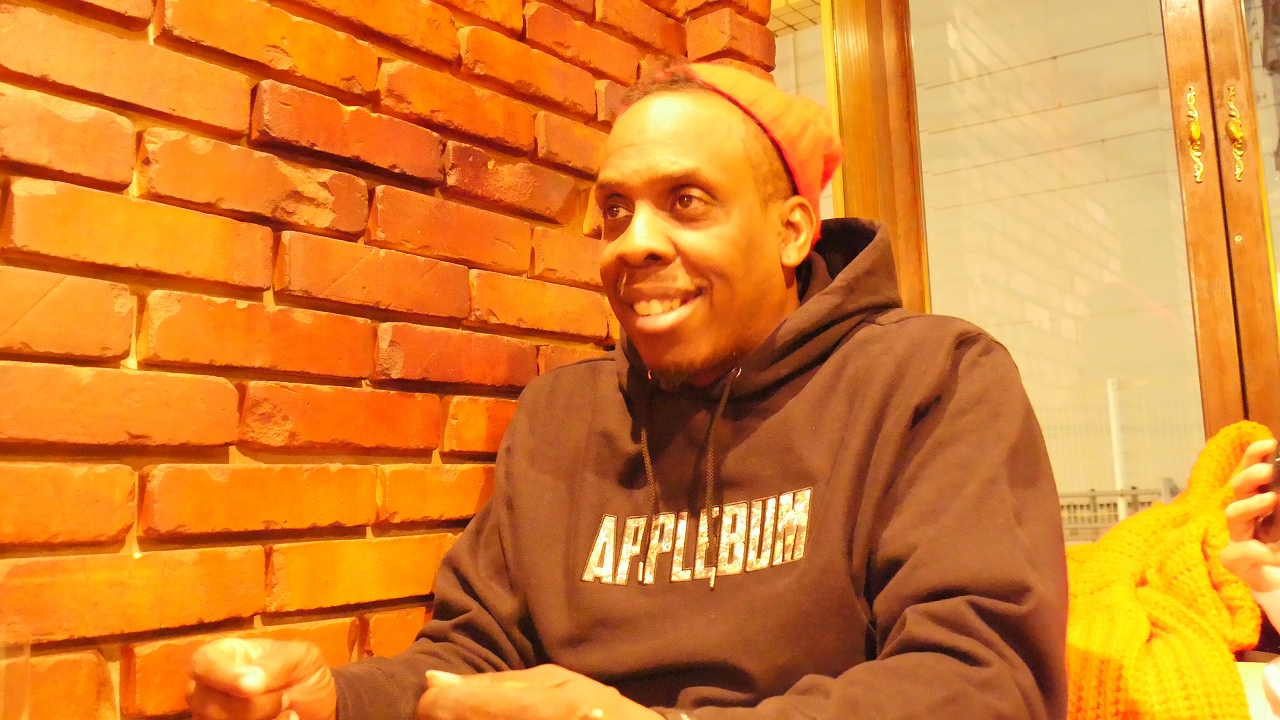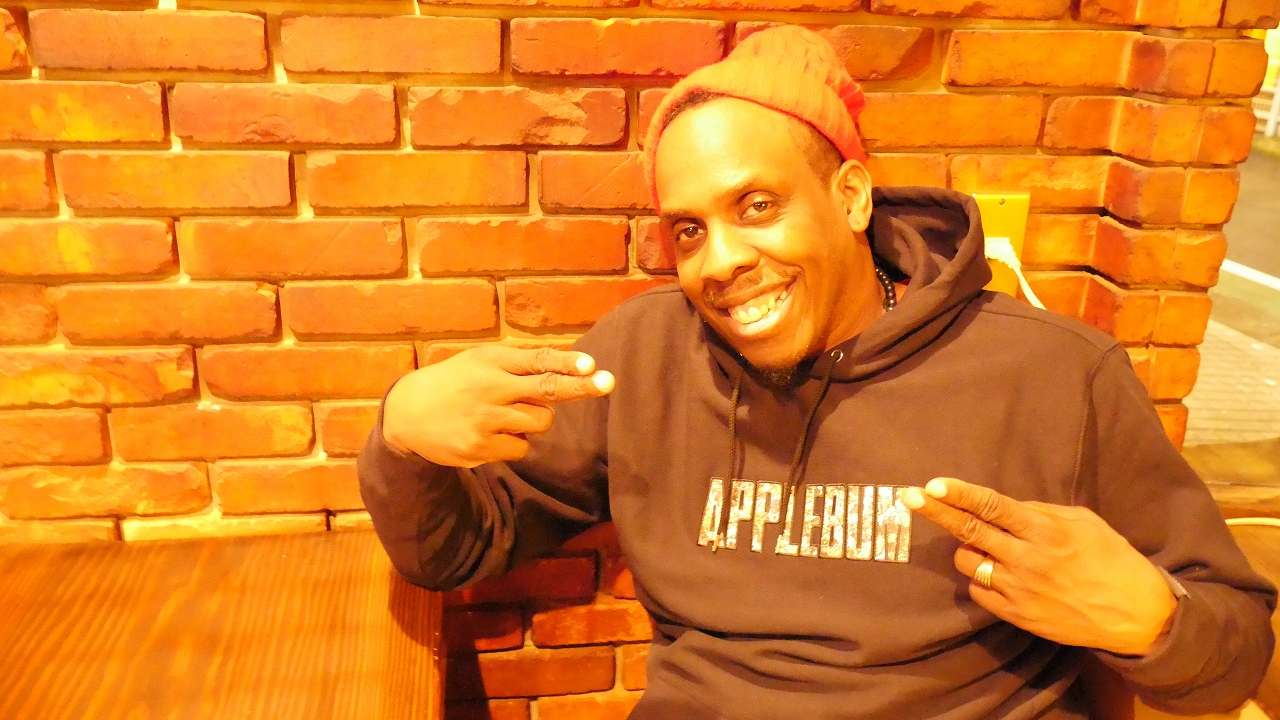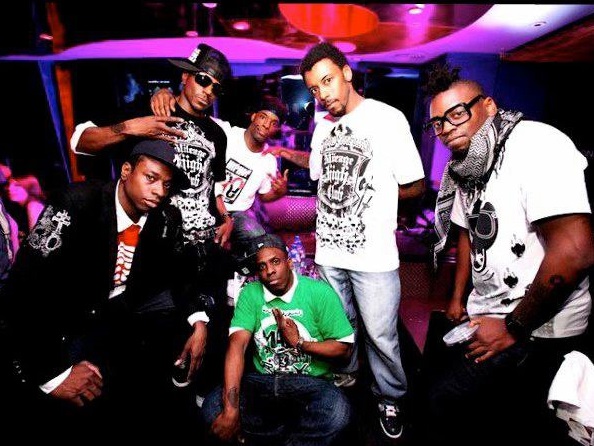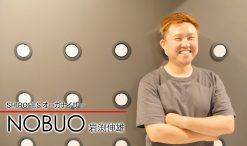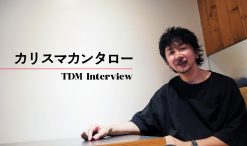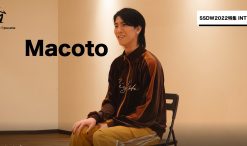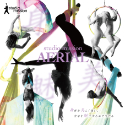
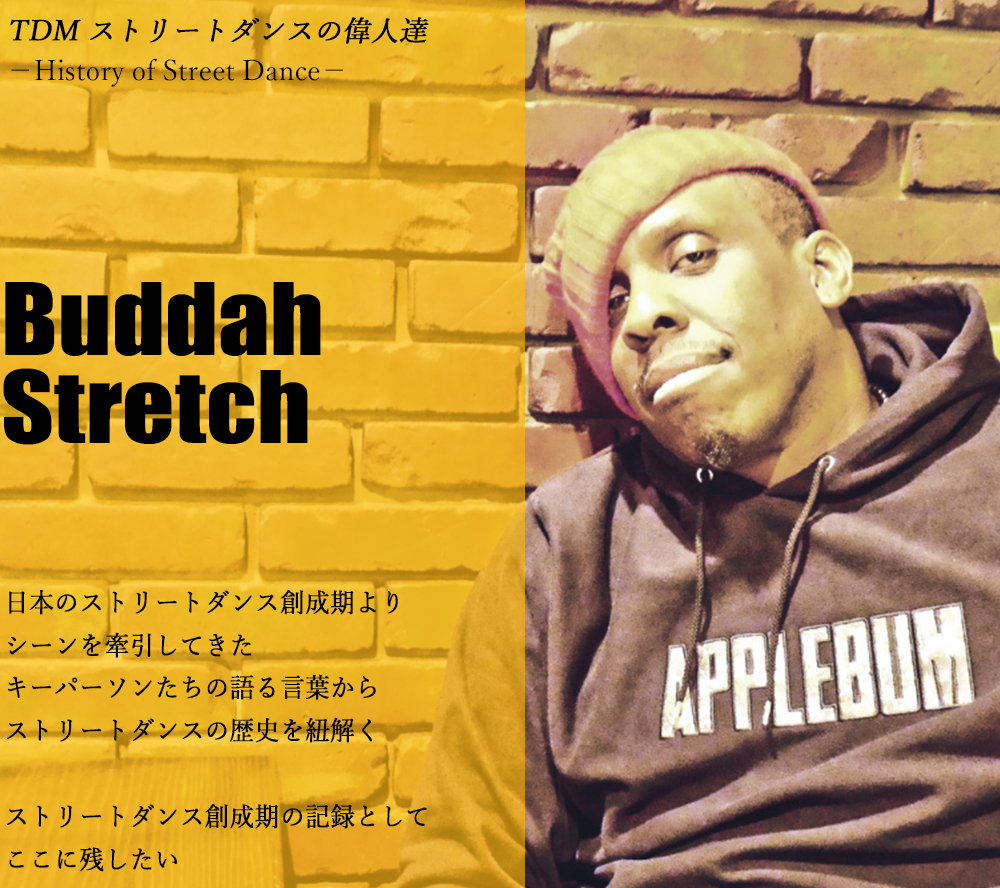
言わずと知れたHIP HOPダンスのオリジネーターチーム、Elite Force(エリート・フォース)の創始者で、マイケル・ジャクソンやマライア・キャリーなど名だたるアーティストが信頼を寄せる人物Buddah Stretch(ブッダ・ストレッチ)。
彼の生きてきた軌跡こそが、ストリートダンスの歴史と言っても過言ではないだろう。そんな彼に、日本のHIP HOPカルチャーへの想いや最新のN.Y.ダンス事情まで、さまざまな話を聞くことができた。ストリートダンス、HIP HOPシーンに関わる全ての人必読です!
Buddha Stretch, the founder of Elite Force – the pioneer team of Hip-Hop dance. Stretch has gained unbeatable trusts from world’s most celebrated artists such as Michael Jackson and Mariah Carey.
His own history is indeed the history of street dance. We had a great opportunity to interview him. Enjoy exciting stories ranged from his thoughtful insight into Japanese Hip-Hop culture to the latest dance scenes in New York. Must read for everyone involved in street dance and Hip-Hop!
・Buddah Stretch(エミリオ “ブッダ・ストレッチ” オースティン Jr.)
N.Y.のブルックリンで生まれ育ち、青年期に父親の影響でダンスを始め、長いキャリアーを支える基礎を身につけた。 オールドとニューの溝を埋めるべく、ヒップホップカ ルチャーのあらゆる要素を取り入れたフリースタイルヒップホップダンスを極めた彼はEric B & Rakimやマライア・キャリー、ウイル・スミス、マイケル・ジャクソン等、数多くのトップアーティストの振り付けやバックダンサーを務めるなど輝かしい経歴を持つ一方、世界中のアンダーグラウンドシーンでの貢献は計り知れず、MCや演劇活動もこなす先駆者であり「伝道者」である 。本人によると、「音楽とは世界共通言語であり、その通訳になるのがダンスだ」。
Buddha Stretch, Emilio “Buddha Stretch” Austin Jr.
Born and raised in Brooklyn, New York, Stretch started dancing under influence of his father. This foundation has guided Stretch throughout his long professional career. Stretch heavily impacted the dance world by bridging the gap between Ol’ Skool and New Skool. His dance style, known as Freestyle Hip-Hop dance draws from all aspects of Hip-Hop culture. Alongside his brilliant career as choreographer and dancer working with many top artists such as Eric B & Rakim, Mariah Carey, Will Smith and Michael Jackson, his contribution to the underground dance scene around the world is immeasurable. His versatility is also displayed by his pioneering activities as an MC, theater/musical choreographer and teacher. Stretch believes “music is the universal language; dance is its interpreter.”
※Followed by English translation.
TDM:最初にダンスを始めたきっかけを教えてください。
BS:僕がダンスを始めたのは、僕の家族にとってダンスは社会的なものだったから。親戚の結婚式やパーティーなどでは、僕の家族は全員踊っていたからね。でも、ストリートダンスは、テレビ番組「ソウル・トレイン」でElectric Boogaloos(エレクトリック・ブガルーズ)※1を見るまで踊っていなかった。
南部出身で僕より2歳年上の従兄弟チャールズが、北部にある我が家へ遊びに来た時、地元の人たちが外に集まって踊るブロックパーティーがあって、近所の人達が皆集まって踊っていたんだけど、チャールズがそのダンスの輪の中に入って、ポッピングを始めたんだ。彼は踊ったことがなかったのに!それが「ソウル・トレイン」のダンスだった。
「彼ができるなら僕でもできる!」と思って、ストリートダンスを踊り始めた。
それから1年くらい経って、近所のB-BOYたちのクルーに入ってブレイキングを始めて、そこで、ブレイキン、ラップ、DJ、グラフィティが、HIP HOPと呼ばれるものの全てであることを学び、それを全てをやろうと決めた。そして、それは僕の人生を変えたね。
※1 Electric Boogaloos:Boogaloo Sam(ブガルー・サム)を中心としたポッピングのオリジネータークルー。
TDM:従兄弟のチャールズさんは、そのダンスがポッピングということを知らなかったんですか?
BS:チャールズは、僕と同じようにテレビでただ見ていただけなんだ。当時は、彼だけではなく、皆真似していたんだけど、僕はチャールズが踊るのを見るまで入り込むことはなかった。でも、「まあ、彼ができるんなら、僕もできるんじゃないか」という思いで始めたんだけど、本当に上手くなったんだよ。当時14歳の高校生だったんだけど、ストリートダンスを始めてからは、多くのダンサーに会い、クルーに参加したりと、ダンスが私の人生になったんだ。
TDM:Elite Forceはどのように結成されたんですか?
BS:Elite Forceのメンバーは、もともと仲のいい友達だった。Caleaf(カリーフ)、Loose(ルース)、Link(リンク)、そしてEjoe(イージョー)も一緒にMop Top(モップ・トップ)というチームをやっていたんだけど、ある日、マイケル・ジャクソンの振付をしてほしいという電話があり、ミュージックビデオの仕事で、LinkとLooseもオーディションに参加していた。
オーディションは30人のダンサーがいて、一列6人のダンサーが5列に並んで臨んでいて、最前列がベストダンサーたち、二列目がその次、最後列がワーストという感じに並んでいた。僕とLooseは最前列でマイケルの隣だったんだけど、Linkはオーディション期間の最初の方は病気で参加できなかったから最後列だった。
でもLinkは、「こんな後ろになんかずっといないぞ。前に上がってお前らと一緒にマイケルの隣で踊るんだ」と言って練習を重ね、週を重ねるごとに上手くなっていった。そして、一列ずつ前に上がっていって、最終的に、撮影前には最前線に合流したんだ。そして、彼はこう言った。「俺はエリートの仲間入りしたぜ!」ってね。そうやってクルーが始まったんだよ。
Linkは、「俺はエリート(Elite)の中にいる。今や俺たちは力(Force)だ、俺たちを止めることはできない!」と言った。だからチームの名前は、Linkが最前列のエリート(Elite)にのし上がってマイケルの隣で踊るために頑張る彼の姿から来てるんだ。彼がそう言った時、僕とLooseも、「僕たちは力(Force)で、誰にも止めることはできない」と思うようになった。それはElite Forceそのもの。だから3人でクルーをやろう、それをクルーの名前にしようと決めてから今まで、僕たちはクルーとして全てを共に過ごしてきた。当時僕は23歳だった。本当に若かったね。
TDM:マイケルと仕事をしたことで、人生は変わりましたか?
BS:全てが変わったね。それまで何年も前からHIP HOPの仕事をたくさんしてきたし、お金も稼げて、すべて順調だったけど、このマイケルとの仕事は最も大きな仕事だった。なんてったってマイケル・ジャクソンだからね。これ以上デカい仕事はないよ(笑)。この仕事以降、父に「これでお前はプロだ。楽しいだけじゃなく真剣にならないとダメだ。本当にお金をもらうなら、本当に仕事に集中してビジネスをしろ」と言われたけど、実際に真剣になったよ。
父は僕たちがプロとしての自覚があるか確認したかったんだ。「皆プロにならないとダメだ。なぜなら僕たちは今トップレベルなんだから、本当に真剣にやらないとダメなんだ。」という意識をElite Forceだけじゃなく、Mop Topのメンバーも含めてクルー全員にね。
僕たちはマイケルとの仕事がきっかけで羽ばたいていったんだ。
ちょうど同じ頃、マライア・キャリーとも仕事を始めた。マライアとは「ソウル・トレイン」でも共演して、マライアの最初のミュージックビデオ「Dream Lover」の振付を僕が担当し、Mop TopとMisfits(ミスフィッツ)※2のダンサー全員でこのビデオに出演してから今でも一緒に仕事をしているよ。
※2 Misfits:Elite Force同様、HIP HOPの基礎を築いた伝説のチーム。
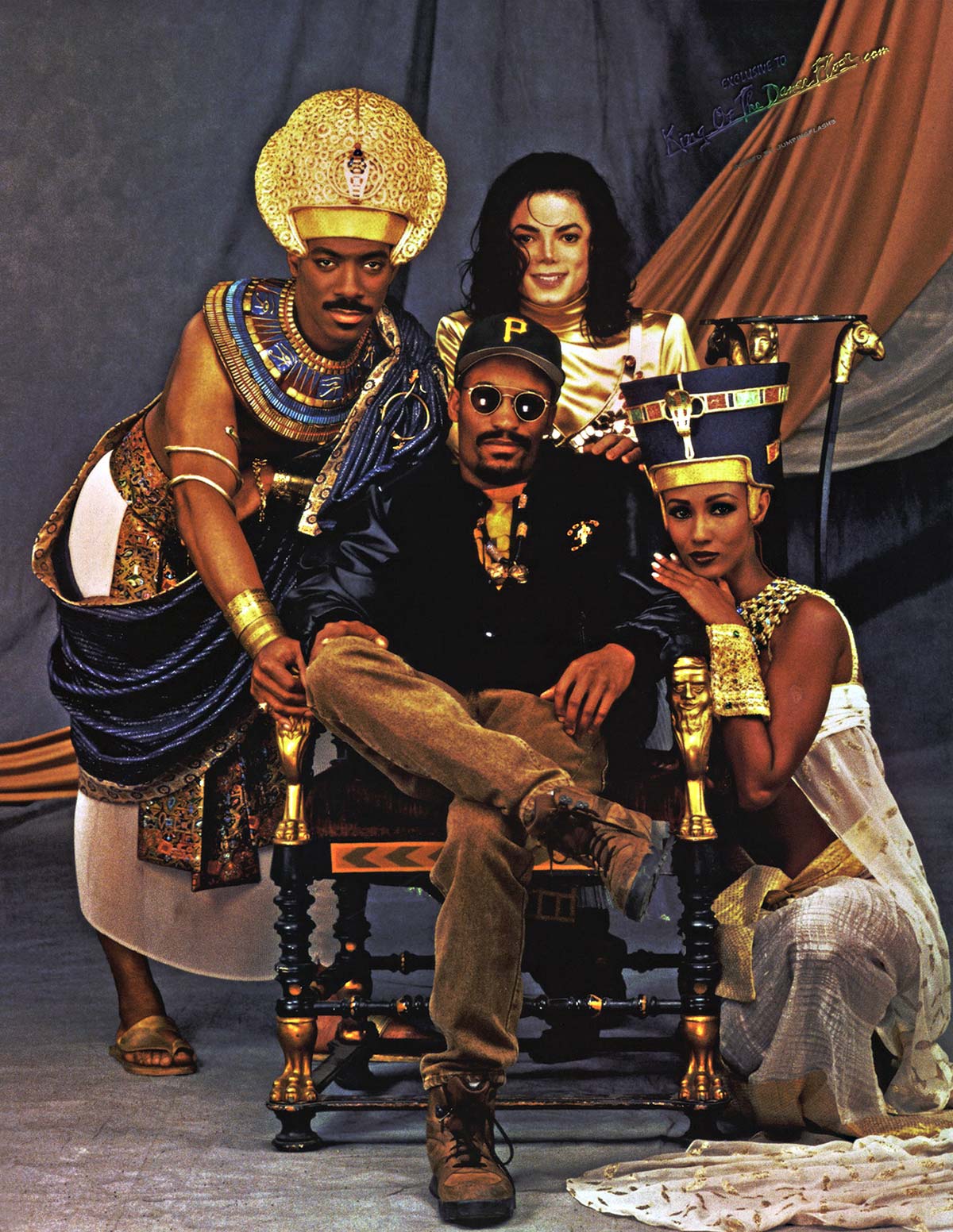 Michael Jackson 「 REMEMBER THE TIME」Music Video
Michael Jackson 「 REMEMBER THE TIME」Music Video
TDM:30代はどうでしたか?
BS:30歳の頃。1998年、ダンスを始めてから17年くらい経った時期なんだけど、マライアの3回目のツアーをやっていて、僕は彼女のツアー、ビデオ、ショー、テレビ、全ての振付をするようになっていた。同時期に、映画「メン・イン・ブラック」、「Gettin’ Jiggy With It」や「Miami」のミュージックビデオなど、ウィル・スミスとの仕事も始まったから30代はたくさん仕事をしたね。今もそうだけど、同時にマイケルの仕事もあったからちょっと違うレベルだったな。
ウィルとの仕事は、例えば「メン・イン・ブラック」は単なるミュージックビデオではなくて映画だったから、監督やIndustrial Light & Magic(インダストリアル・ライト・マジック)※3とのミーティングにも参加したんだよ。彼らは映画「ジュラシック・パーク」などのメジャーな映画のスペシャルエフェクトを担当した本当にレベルの高い人たちで、僕はその中に「うわー!」っていう感じで座ってた。
超有名な人たちの中で、僕は一介のヒップホップダンサー。なんか居心地が悪くって、皆が自己紹介して、最後に僕の番が来たとき「どうも…ストレッチといいます。ヒップホップダンサー、振付師です」と、静かに謙虚に言ったんだ。そしたらウィルが「とんでもない!彼は最高なんだよ。マイケル・ジャクソンと仕事してるんだぜ!」と、彼は皆に僕のキャリアを全て語り始めた。そうやって、皆に僕がトップレベルのダンサーだと認識させてくれたんだ。とても嬉しかったけど、やっぱりこの人たちはハリウッドのビッグネームだと思うと本当に怖かったな。彼らとの仕事はクールで楽しかったし、マイケルと同じくらいハイレベルの仕事だったよ。
※3 Industrial Light & Magic:アメリカの有名な特殊効果及びVFXの制作会社。
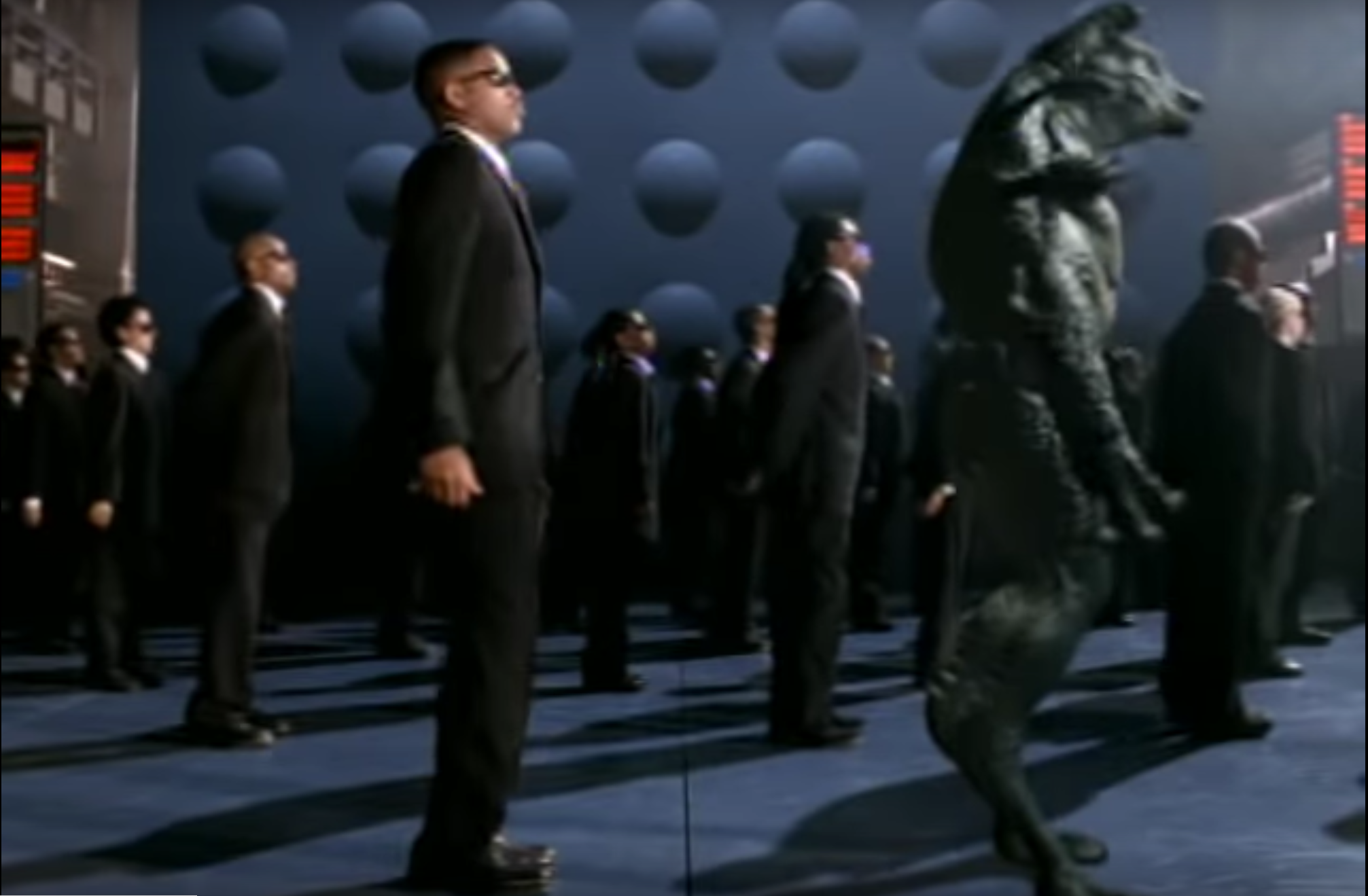 Will Smith 「Men In Black」Official Music Video
Will Smith 「Men In Black」Official Music Video
TDM:ウィル・スミスさんは昔からの知り合いなんですか?
BS:1986年にウィルの最初のN.Y.でのショーで会ったんだ。もう30年くらいになるかな。ユニオン・スクエアというクラブでウィルがDJ Jazzy Jeff (DJジャジー・ジェフ)とショーをした時、僕たちがオープニングアクトを務めたんだ。その翌年、僕たちは有名なラップ・グループ、Whodini(フーディーニ)のツアーの仕事をした。彼らはショーにダンサーを入れた最初のグループだったんだけど、そのツアーに、ウィルたちが合流して仲良くなったんだ。
ウィルが「メン・イン・ブラック」の時に電話をくれたので、「この映画で何をすればいい?」と聞くと、「振付を考えて欲しいから、うちに来てくれないか」というので、僕はL.A.に飛んで、映画で使う曲を聴かせてもらい、映画のクリップを見たんだ。
ウィルが「これが撮影スケジュールだよ、君のクルーはどこ?」と言うので、Ejoe、Link、Brooklyn Terry(ブルックリン・テリー)に電話して「おい、L.A.に行くぞ、今すぐだ!」とね。その時は29歳だったね。
30代になると、振付やミュージックビデオ、ステージだけの生活だけじゃなく、本格的にダンスを教え始めた。スタジオでレギュラークラスのレッスンを始めて、ワークショップでさまざまな国に行くようになって、日本にはいつも来てたね。
韓国にも行くようになり、台湾、中国、ヨーロッパ、いつも旅をしながら教えるようになったんだ。そんな風に過ごしていたのが30代の始まり。それから演劇やミュージカルの舞台もやり始めた。
Rennie Harris(レニー・ハリス)※4とも仕事をして、彼のカンパニーPure Movement Dance Company(ピュア・ムーブメント・ダンス・カンパニー)と、ブロードウェイのショーや、N.Y.、L.A.、ロンドンの劇場でもショーをした。それからバトルのジャッジの仕事が入ってきて、40歳になった時には、年中世界中を旅して、ジャッジをしながら教えをするようになった。それは今もずっとやっている。
40歳になったときJuste Debout※5のツアーでさまざまな国へ行った。レッスンだけの国もあれば、ジャッジ、レッスン、パフォーマンス、DJもやったり、いろいろさ。
僕が行くときはだいたい音楽(DJ)もやる。HIPHOPはダンスだけではないから、いつも他の要素も表現するんだ。
※4 Rennie Harris:ストリートダンスのパイオニアであり、全米30以上の賞を受賞している芸術監督・振付師。
※5 Juste Debout:フランスのパリで行われている世界的にも有名で大規模2on2バトルイベント。
TDM:これまでに訪れた中で最も記憶に残っている国はどこですか?
BS:最も記憶に残っているのは3カ所。1つ目はイギリスのロンドン。CaleafとLinkと僕が生まれて初めて行った海外だった。ロンドンはダイアナ・ロスのダンサーとしてツアーに行ったんだけど、我々がロンドンに着いてから就労ビザがないことが発覚して、「ダメです。帰国してください」って言われた。現地でダイアナ・ロスに会ったとき、ビザが取得されていなかったことを謝まっていたよ。僕たちは一緒に食事をして、一晩だけロンドンで滞在を許されたので、クラブに行って徹夜で踊ったよ(笑)。そして、翌朝アメリカに帰ったんだ。だから、ダンスの仕事で行った初めての海外は一晩だけで帰って来なければならなかったんだ。
2つ目は日本。初めて東京に来たのは、1990年にアパレルブランドMen’s Bigiのファッション・ショーの仕事で呼ばれて、ランウェイでのショーや撮影をやったね。1994年以降、現在まで少なくとも年に一度は日本に来てるね。
TDM:日本はお気に入りの国なんですね。
BS:こんなにたくさん来るようになった国は日本が初めてだよ。好きな国の3つ目はブラジル。ブラジルに行ったとき、皆僕が外国人じゃなくてそこで生まれ育った特別な家族かのように接してくれて本当に素晴らしかった。ブラジルの人々は美しくて、とても親切で、スピリチュアルな繋がりを感じたよ。ブラジルは愛が溢れてるんだ。1年に4回も行ったこともあるし、いろいろな街に行ったね。
ブラジルにはダンサーがたくさんいて、B-BOY Neguin(ビーボーイ・ネギーン)※6にも会ったよ。彼はカポエイラとブレイキンをミックスしたスタイルが本当に素晴らしくて、本当にいいダンサーなんだよ。
※6 B-boy Neguin:ブラジルを代表するワールドクラスのB-BOY。
TDM:年齢に関係なく、今好きなダンサーはいますか。
BS:まず、兄とも言えるElectric BoogaloosのPoppin’Pete(ポッピン・ピート)、故Skeeter Rabbit(スキーター・ラビット)、Mr. Wiggles(ミスターウィグルス)、Suga pop(シュガー・ポップ)、Boogaloo Sam(ブガルー・サム)、Crazy Legs(クレイジーレッグス)、Ken Swift(ケン・スウィフト)、Rock Steady Crew(ロック・スティディ・クルー)とたくさんいるよ。
僕がダンスを始めた頃に見ていた彼らは僕のヒーローだ。彼らにはたくさんインスピレーションをもらったし、今では家族だよ。
その前はLOCKERS(ロッカーズ)※7だね。毎週土曜日に「ソウル・トレイン」を見ていて、当時はLOCKERSのことさえ知らなくて、ただ自分の大好きなダンサーたちを真似しようとしてただけだった。何年も後に番組の再放送を見て、あれはロッキンだったと気付いたよ。後にDon Campbell(ドン・キャンベル)※8やGreg Campbellock Jr.(グレッグ・キャンベルロック・ジュニア)※9にも会うことになるんだけど、そのときに、子供の頃にテレビで見ていた人たちだと気付いた。今では本当に仲の良い親友であり家族だし、今も彼らと一緒に踊ってるんだ。
※7 THE LOCKERS:ドン・キャンベルを中心に結成されたロックダンスを作ったオリジネータークルー。
※8 Don Campbell:1969年にロックダンスを生み出した創始者。
※9 Greg Campbellock Jr:ロッカーズのオリジナルメンバー。2010年逝去。
TDM:若い世代で好きなダンサーはいますか?
BS:オランダやドイツ、韓国にも素晴らしいダンサーがたくさんいるし、中国には本当に驚愕のキッズダンサーがいて、彼らのレベルは本当に高いんだ。日本にも若いB-BOYがいるよね。今の若い世代より、さらに若い子たちが世界中いろんな所で力をつけてきているのは素晴らしいことだね。
TDM:年に1度は日本に来ているということですが、日本のストリートダンスはどんな風に変わってきてると思いますか?
BS:日本のストリートダンスは世界の他の国々よりも長い歴史があるよね。HIPHOPの創始者Afrika Bambaataa(アフリカ・バンバータ)と、ダンサーたちが初めて海外ツアーを行ったのは確か1982年。最初はヨーロッパで、イギリス、フランス、ドイツ、イタリアに行って、それから日本に来たんだ。だから日本にストリートダンス文化が入ってきて結構経つんだよ。今日本のHIP HOPは、たぶん4世代目くらいになっているんじゃないかな。
僕はその文化の成長の過程とそれぞれの世代を見てきた。最初は同世代のダンサーに会って、それから彼らの子供たちが産まれて、さらにその子供たちへと3世代に受け継がれてきたんだ。だから、今の子供たちにとっては、ストリートダンスの文化はもはや意識しなくてもそこにあるもので、もう外から習得しなければならない外国文化ではなく、日本の文化なんだよ。
文化を理解するプロセスやムーブメントは昔とは全然違う。僕たちがそうだったように、彼らはその文化の中で生まれ育ってるからレベルが高い。だからこそ日本のダンサーたちはとても素晴らしいんだ。
それは日本だけの話ではなくて、世界中いろいろな所で起こっているよ。それくらいストリートダンスカルチャーは世界中で受け入れられて成長してきている。今は、世界中の学校が体育としてダンスを取り入れるようになり、学校制度の一部になっているよ。学校でストリートダンスを学んでいるから子供たちは踊るようになったし、彼らが踊りたいのはストリートダンスなんだ!
日本はストリートダンスカルチャーを長い間育んできた。それこそ日本が特別な理由なんだ。だから中国、韓国、台湾といった国は皆日本をモデルにしているよ。
TDM:今のN.Y.のストリートダンスシーンはどうですか?
BS:N.Y.では、HIP HOPはこれからも常にスペシャルなものであり続けると思うよ。
N.Y.にいつも新しいものがあるのは、そこでストリートダンスが生まれたから。過去10年間でみても、毎年何かしら新しいダンスや映像作品、キャッチーなものが生まれてるね。
それこそが文化だから子供たちは常にクリエイティブだし、HIP HOPは人生を祝福してくれるものなんだ。そして、我々が乗り越えてきた愚かな抑圧や人種差別の経験を忘れない限り、ダンスと音楽は常に僕たちのそばにある。それは僕たちが表現のかたちとして必要としているもの。そうやって僕たちは戦っているんだよ。
N.Y.だけでなく、アメリカ中で常に新しい創造的なダンスや音楽、スタイルが生まれていて、例えば、同じアメリカ南部でも、ディープサウスと北のほうでは違うスタイルがあるし、中西部、西海岸、西海岸の北部でもそれぞれ異なるスタイルを持っていたり、あらゆる地域で独自のスタイルがあって、皆お互いに影響を与え合っているね。
実はN.Y.では今、新しいムーブメントが起こっていて、12、3歳の若いダンサーたちがLiteFeet(ライトフィート)という新しいスタイルのHIP HOPをやっていて、今、世界中で有名になっているんだ。皆YouTubeでいろんなダンサーを見るのが主流になっているから、これが今の子供たちにとっての最新のHIPHOPだね。
N.YではWaffle Dance Crewという有名なチームがいるんだけど、メンバーの一人であるKid The Wizは、ダンサーだけど音楽もプロデュースしてるんだ。彼らがビデオを作るとき、Kidが作る音楽に合う映像を作るので、ダンスはさらにスペシャルなものになって、その中で踊るダンサーは最高だよ。
彼らは前からあるものを土台にして、彼ら自身のHIPHOPのスタイルとそれに合う音楽を作ったんだ。彼らが特別なのは、ダンスを作って、さらにそのダンスに合う音楽を作ったこと。ダンサーが音楽も作ったんだ!
TDM:それはとても革新的なことですよね。
BS:今までは、だいたい普通のHIP HOPミュージックに合わせて踊っていたからね。でも、ダンサーたちはダンスに合う自分たちの好みの音楽を作り始めた。そうやってダンスに本気で向き合う姿勢こそがカルチャーだからね。このダンスがすごい人気となった理由は、独自の音楽を作ったからだと思う。
TDM:ご自身のチーム「Elite Force」について聞かせてください。
BS:Mop Topは1989年に結成したから今年で29年目、Elite Forceは26年目になるよ。Elite Forceはダンスが主で、Mop Topはもともと僕たちが思った通りのやり方で、ラップ、ダンス、DJ、アート、すべてやってる。まさに生きる姿勢というかね。
父が僕に言っていたことは「何かをやるなら、すべて高いレベルでやるべきだし、真剣にやらないといけない。そうでなきゃやるな」だった。そして「これがおまえがやるべきことだ」と言った。そして僕はCaleafにもそれを伝えたんだ。Caleafも「オーケー、みんなでこれをやらないとな」と言って皆にもその考えを共有し始めたんだ。これから僕らはこうやって動くぞって、そうして皆もそうするようになった。僕らはいつも一緒にいたからね。その考え方がクルーの名前になったんだよ。
最初、周りの人たちは、この名前を僕たちのドレッドヘアのことだと思っていたんだよ(笑)。でも、当時の僕とLinkの髪型はフラットトップだったけどね。Linkのフラットトップはすごく大きかったよ!
TDM:チームで活動していく上で一番大切にしていることは何ですか?
BS:父が言ったように‟プロフェッショナルであること“。ビジネスなら、どんな仕事かに関係なく、プロフェッショナルとしてビジネスに向き合うべきだと思う。
それがダンスであれ音楽であれ何であれ、真剣に取り組まなければならない。父はいつも「楽しむことはいいが、ビジネスをしっかりやってからにしろ」と言っていたんだ。ビジネスをしっかりやれば楽しみはもっと大きくなるんだと。
チームとして最も大切なことは、僕たちはチームであると同時に、強い個人の集まりだということ。 LinkもCaleafもすごい、SHAN.S(シャネイ)※10 、CEBO(シーボ)※11もすごい。僕たちが全員集まったら、誰も太刀打ちできないし止められないんだ。個人でも強力だけど、僕たちが一緒にいるということが重要なことで、チームでこそ最強なんだ。スーパーサイヤ人みたいにね(笑)。
※10 SHAN.S :ハウスダンスのオリジネーターチームDance Fusionのリーダー。
※11 CEBO:N.Y.を代表するハウスダンスクルーNext Generationのマネージャー兼コレオグラファー。
TDM:良いチームワークを維持する上で苦労していることはなんですか?
BS:いつもしているよ。皆人間だし自分の考え方があるし、不安もあるから、間違うこともある。でも、間違うからこそ、そこから学ぶんだ。大事なのは意見の食い違いやトラブルを乗り越えていくこと。
僕たちはいつも喧嘩したり議論したりするけど、それが家族だよね。違う意見がなければ学ぶことはできないし、そうやって一緒に向き合うことでもっと強くなれるんだ。これが全て。悪いことがあっても、そこから学んで良いことに変えられることは人間の美徳の一つだからね。
だから、僕たちは皆変わらずここにいられることを毎年祝福するんだ。だって来年僕たちがここにいられる保証はないからね。僕たちは、この3年の間に大切な仲間を2人失った。2015年にMarjory(マージョリー)※12、2017年にVoodoo Ray(ブードゥーレイ)※13をね。
一緒にいるこの時間は二度とない特別なものだと分かっているから、僕たちはいつも集まって祝福し慈しむんだ。昨年はDance Fusionの20周年だったので「祝おうぜ!」とかね。これからもいろいろなグループがたくさん出ては消えるだろうけど、僕たちのようなクルーは決して現れないだろうね。
そして今、僕たちの子供たちも一緒にここにいられる。娘たちは、今回の来日に合わせて初めて日本に来るんだ。SEKOU(セクー)※14と彼の娘のGyasiも一緒にね。Caleafの息子は去年彼と一緒に来たし、こうやって子どもたちを連れてくることができるようになって、子どもたちも自分の目で日本を見られるなんて特別なことだよね。
※12 Marjory:DANCE FUSIONのメンバーであり、世界のハウスシーンに最も影響を与えた女性ハウサー。【→TDM Marjorieインタビュー】
※13 Voodoo Ray:Mop Top、Elite Forceのメンバーで、ストリートダンス界のパイオニア的存在の1人。
※14 SEKOU:DANCE FUSIONのメンバー。
TDM:最後に日本のダンサーたちにメッセージをお願いします。
BS:さっきも言ったように、ストリートダンスカルチャーはいまやもうアメリカだけの文化ではなく、日本のもの、日本の文化でもあるんだ。日本人の素晴らしいところは、ストリートダンスカルチャーが世代を超えて根付いていること。だから僕は日本のダンサーたちに、「考え過ぎてはいけない。違うことをすることを恐れてはいけない」ということを理解して欲しい。
日本は、何か普通ではないことをすると、それだけで奇妙な目で見られてしまう。でも、普通でないことこそが変化をもたらすんだ。好むと好まざるとに関わらず変化は必ず起こる。それなら変化がただ自分の周りで起こるよりも、自分が変化のプロセスの一部になるほうがいいじゃないか!
日本には独特の雰囲気があって、ベテランのダンサーの中にはダンスのステップや歴史について考えすぎる人たちもいるけど、若いダンサーたちは考えるよりもただ感じたいだけなんだ。日本人はこの「先輩、後輩」という考え方はやめなければならないと思う。ベテランのダンサーたちはもっと若いダンサーを見てインスピレーションを受けないとダメ。せっかくならお互いに影響し合わないと!インスピレーションは一方通行ではなく両方通行なんだよ。サイファーみたいにね!
TDM:今日は貴重なお話をありがとうございました!
Interview and Translation by Jun Akimoto
edit by Yuri Aoyagi
photo by AKIKO
’19/2/20 UPDATE
TDM:Can you first tell us how you met dance?
BS:I started dancing because, in my family, dancing is a social thing. All of my family can dance. On my father’s side and my mother’s side, weddings, parties, everybody dances. But as far as street dance, I didn’t get into street dance until I saw the Electric Boogaloos on “Soul Train”. And I saw my cousin, his name is Charles, he is two years older than me, we grew up together, but he never danced. Then we have what they called a block party, it’s a party outside in the neighborhood, and all the neighbors come. So my cousin, he’s from the South. He came to meet with the family in the North. And so they have the party outside. He jumps in the circle and he starts popping. Wow, that’s the dance from “Soul Train”. But I saw, it was like, if he can do it, then I can do it. So that’s how I got into it.
And then when, maybe, like a year or so later, I met the b-boys in my neighborhood and joined the crew. And I got into breaking also. And then I learned that breaking, rapping and DJing are all one thing called Hip Hop. And so when I learned all this, I wanted to do everything. It took over my life.
TDM:Your cousin didn’t know that his dance was supposed be called popping?
BS:He just saw as the same way I saw it. He saw it on TV and people were doing it. But you know, I didn’t get into it until I saw him do it. You know, when I saw him do it, I’m like, well, if he can do it, I can do it. And then, you know, I got really good at it. When I started, I was fourteen years old. That’s when I first started. My first was at the high school I started to dance and I met many dancers, and then joined the crew. You know, that’s when it took over my life.
TDM:We would like to hear how you created your team, Elite Force.
BS:Well, Elite Force, actually we were really good friends first. And we were together with Caleaf, Loose, and Link, and then E-Joe. We had our whole team called Mop Top. And then I got a call to do choreography for Michael Jackson. And when I went to do this video, Link and Loose flew an audition for the video, so they both made the video.
So in the beginning of the rehearsals, we have thirty dancers. So it’s six dancers in each five rows. The front line is the best, second best, third best, fourth best, last. Loose joined and we are right here next to Michael, but Link was sick, so he couldn’t do the choreography at first so Link was back here.
So he says I’m not going to be in the back, I have to make it to the front because I have to be with you guys next to Michael. So he practiced, and every week he got better. So we moved him up one line. And before we film, he made it to the front line. And when he made it to the front line, he said, I’m in the elite. And that’s how the crew started.
He said, I’m in the elite. Now we’re force, we can’t be stopped. And so that name is from him working to get to the front next to Michael, to be in the elite of the people in the front. So once he said that , we started thinking about, we are force, we can’t be stopped. And it was like, elite force. Let’s start that crew. That became us three there. We decided, okay, that’s going to be our crew name. We’re going to be crew from here on out, everything we do together. I was twenty three years old then. Yeah, really young.
TDM:When you worked with Michael, did it change your life?
BS:Yeah, that completely changed everything. I’d been doing jobs for Hip Hop for many years before, making money and everything was good. but this was the biggest job. It’s Michael Jackson. It doesn’t get bigger than that. After this job, my father came and he said, okay, now you are professional. You have to be serious, not just fun. Now you’re really getting paid. You have to really focus and do business. And so now it became serious.
My father made sure that we were professionals. Everybody had to be professional now. We had to really be serious because now we’re top level. All of us, not just Elite Force, but all of Mop Top, all of our crew.
So working with Michael was the beginning when we took off.
Right around that same time is when we started to work with Mariah also. We did Mariah again on “Soul Train”. And so after that, then her first music video where she did a “Dream Lover”. That’s when she hired me as a choreographer. And then I bring the whole team all of the dancers in Mop Top, Misfits, all of us together in this video, and so now we always working together.
TDM:How was your thirties like?
BS:When I turned thirty, that’s 1998 this is maybe seventeen years later. This is when we did Mariah’s her third tour. Now i do all of her choreography for tour, video, state show, TV, everything. Also at this time is when I start to work with Will Smith and did “Men in Black”, “Gettin’ Jiggy With It”, “Miami”. So in my thirties, I’m doing a lot of work. It’s the same but now it’s another level because now we did Michael.
But now when I’m doing with Will, “Men in Black” is not just a music videos, it’s a movie. So we’re in the meeting with the director and Industrial Light Magic, they did the effects for like “Jurassic Park” and all the big movies. And now it’s all these in a really high level people and me, and I’m sitting there like “Wow”!
All these people their credentials are really high, and I’m like a Hip-Hop dancer. So I feel kind of strange, like I’m out of place. But Will, he in the meeting, everybody introduced and I’m the last one, so I just say “Hello I’m Stretch, Hip-Hop dancer, choreographer”. And I’m quiet and humble, but Will says, “No, he’s the best, he did Michael Jackson”. He starts to tell them my resume and everything. And he makes sure that they know that I am up to the job, on the top, and it made me feel good. But I was afraid, like wow! all these people have big names in Hollywood. It was cool and it was fun, you know. And that started from Michael, that was the same high level.
TDM:Have you known Will for many years?
BS:Thirty years? I met Will 1986, his first show in New York. Yeah, his first show in New York with DJ Jazzy Jeff, I was there. We were the opening act, my crew. We danced in the club called Union Square. And then the very next year I went on tour. That was with a famous Rap group called Whodini. They were the first group to have dancers as a part of their show. And so we went on a tour, and Will, Jazzy Jeff came on tour with us and I met them. You know, we hung out, became friends.
So when they did “Men in Black”, Will said “Okay, call Stretch”. So they called me and I’m like, “What do you need us to do in this movie”? And Will said “I need you to come up with some steps and come to my house”, and “Okay”. So flew to LA and they played the song and they showed me clips of the movie. And they said, “This is the schedule, okay, where’s your crew?”. Okay, called Ejoe, Link, Brooklyn Terry, “hey, we’re going to LA and we should be moving”. That was when I was twenty nine.
In my early thirties, I started to move away from choreography, just music videos and stage, and that’s when I really started to teach. I went to teach in the studio again and started teaching regular classes and then traveling, started traveling to different countries. We used to come to Japan all the time.
Then I started to go to Korea, and then to Taiwan, China, Europe and then started traveling and teaching all the time. That was the beginning of my thirties. And then I started to do theater, musical theater. I was working with a gentleman by the name Rennie Harris and his a company called Pure Movement. And so we did a show on broadway, we did theater all over New York, LA, London. And then that became from teaching and theater, and teaching and judging, started judging battles. And that’s what I’ve been doing now from forties until now.
When I turned forty I did Juste Debout tour. And after the Juste Debout tour we went to many different countries. I traveled to the country, judge, teach, but this country just teach, and some places judge, teach, performance, deejay. Some places we went we performed music, always different aspects of Hip-Hop to do. Because we don’t just dance.
TDM:Which is the most memorable country you’ve been to?
BS:Most memorable is, for me, three places. The first place we went ever was London UK. That’s the first place we ever went, Caleaf, Link and I. We were supposed to go and dance with Diana Ross and go on tour. But we didn’t have work visas. So when we get to london, they said, “No you have to go home”. So we spent one night and they let us stay for one night. We met with Diana but couldn’t go with tour because they didn’t get us the visa. So she apologized. We ate and talked, and we went to the club and danced all night. First time to travel outside for dance. Yeah, we stayed one night, we had to come back.
And then the second time I came is here Japan. Yeah, 1990 first time, Tokyo. We did a fashion advertising show for a clothing company called Men’s Bigi. We did a runway show, photography and music video. Then I came back to Japan again 1994, and every year from 1994 till now, I ‘ve been to Japan, every year I’ve been to Japan at least one time.
TDM:Japan must be your favorite country.
BS:BS: Yeah. This is the first place I come the most here. And then, the most favorite place that I went besides those two is Brazil. When I went to Brazil they treat me like I’m a Brazilian, like i’ve been there all my life, not like I’m a foreigner. They made me really feel like special, like a family. And so it was. It was really, really great. People in Brazil are beautiful people, very hospitable. Like it was a really spiritual connection. I went in one year I had to come four times. I went to a few different cities.
There are many dancers in Brazil. I also met B-Boy Neguin. He did Capoeira then he learned breaking, and he mixed together. And he became famous for it because it is really, really good. But he’s a really good dancer.
TDM: Regardless of age, who are your favorite dancers, or dancers you respect at present?
BS:Many, top of the list of my big brother’s Electric Boogaloos’ Poppin’ Pete, God bless, Skeeter Rabbit, Mr. Wiggles, Suga Pop, Boogaloo Sam, Crazy Legs, Ken Swift, Rock Steady Crew.
Those are my heroes I used to watch on TV when I started to dance, I saw them. They were my inspiration and we are family now.
And even before them, the LOCKERS. I used to watch “Soul Train” every Saturday. I didn’t even know who the LOCKERS were. I just know the “Soul Train” live and these favorite dancers and try to imitate everything, that’s all. And then, many years later, when I was watching “Soul Train” rerun, I find out it was locking. And I got to meet Greg Campbellock Jr. and Don Campbell, then I realized these are the people that I watch when I was really young. So when I get to meet them, and now like I’m really close to them, we are really good friends and family. And now I get to dance with them all the time.
TDM: Do you have favorite dancers in younger generations?
BS:Oh yeah. There are many good dancers in the Netherlands, Germany and Korea. And in China, they have really incredible young kids. Their level is really high. Here in japan, too. There is a really young B-Boy. The dancers, younger generations, the youngest generation they’ve got. That’s why they’re so good, and it’s starting that way, not just here, but in different places.
TDM:So you have come here in Japan every year at least once since 1994, how do you see transition of the street dance culture in Japan?
BS:Well, that’s the thing about Japan has had the culture longer than most of the countries in the world. I think it was 1982 when the pioneer of Hip-Hop – Afrika Bambaataa and dancers did the first Hip-Hop tours. They went to Europe, then went to the UK, France, Germany, Italy, and then they came to Japan. So Japan has had the culture for a long time. And so now you have maybe four generations of Japanese Hip Hop.
So I’ve watched it really grow up, watch the generations that grow up. I met dancers from my generation before, and then those dances have kids. And their kids, those kids have kids. So their kids have grown up there are three generations now. So it’s no longer something that they have to think about. It’s no longer a foreign culture that they need to learn. Hip-Hop is part of Japanese culture now.
So the entire process and movement and understanding is totally different now. That’s why the kids are so much better because they’ve grown up in the culture like we grew up in it. That’s why Japanese dancers are so good.
And it’s starting that way, not just here, but in different places. Now the street dance culture’s been so embraced and it’s grown so much. Now, in schools across the world, they’ve taken physical education out there, put dance in. That’s the physical education part. So the kids get to dance, and dance that they want to do is street dance.
Japan, because you’ve had the street dance culture for so long. And so that’s what makes it special. That’s why China, Korea, Taiwan, they’re all modeled after Japan.
TDM: So back in your home New York, how is the current situation of street dance culture there?
BS:At home in New York, Hip-Hop is always going to be special. So there’s always going to be new stuff at home because it’s, you know, that’s where it’s from. I mean, if you think about it over the last maybe ten years, every year there’s a new dance. Every year there’s a new dance, a new video, something catchy.
And it’s always the kids are always creative at home because it’s a part of the culture. It’s a celebration of life. And so as long as we have, basically oppressions and stupid racism and stupid things that we go through, we have dance and music. And so we need that as a form of expression. That’s how we fight that.
So that’s why you see, it’s always something new and creative coming out, not just New York, but in all over America. Different places with different dances, different music, different styles. So in the South, in the deep South, they have one style, and further North South, then the Midwest has a style, West Coast has a style, and Northern West Coast has a different style, so it’s different styles all over. And they all feed off of each other, you know,
And in New York we have a new movement now, it’s like twelve thirteen years old, a new style of Hip Hop called Light Feet. And it’s started to become famous all over the world now, because now everybody’s seen the videos on YouTube online and they see the different dancers, and it’s really popular. That’s the newest Hip-Hop for the kids that they create.
One of the famous crews that is called Waffle Crew in New York and one of the crew is the producer of a lot of the good music, his name is Kid The Wiz. He’s a dancer, but he also produces the music. And so he makes, when they do the videos, he makes the music, and then they make the video to go with the music and the dancers are crazy.
They build off of what came before, and they created their own style of Hip-Hop, and the music to go with it. That’s what makes it really special because they made the dance, and then they made music to go with the dance. The dancers made the music.
TDM:That’s truly innovative.
BS:Well, before they did the dance to regular Hip-Hop music. But then they started to make their own kind of music own kind of Hip Hop to go with the dance because there’s a whole culture and attitude to the dance. And so they made a music to go with it. And to me, from my perspective, that is what made the dance become super popular because it had now its own music.
TDM:Can you tell us more about your own teams?
BS:Mop Top, we started eighty nine so this is the twenty ninth year. Elite Force, this is the twenty sixth year. Originally, Mop Top was just the way we think, Rap, dance, DJ, art, everything, you know, our method of operation. It was originally just an attitude.
And it’s something that my father said to me about, every time that you do something, you have to do it at a high level and be serious about it, or don’t do it at all. And so he told me that, in my mind, this is what I had to do, and then I told Caleaf, and he’s like, okay, we all need to do this. So he started to tell everybody like, this is how we move. Now we’re all gonna move like this. So everybody’s like, ok, and then that was how we moved. And then, you know, with the idea, because we were always together. That became the name of the crew, you know. But people used to think it was because of our hair. But when we started, none of us had dreadlocks. I had a flattop. Me and Link, Link had a really big flattop.
TDM: What is the most important thing for you to run your company?
BS:For me, it’s, like my father said, to be professional. When we’re doing business, no matter what business you’re doing, it has to be run like a business to be professional about it. So if it’s dance, if it’s music, if it’s whatever it is, you have to be serious. You have to take it seriously. So my father always told that, so he said you can have fun but have fun after you take care of the business, because if you take care of the business, the business will make the fun better.
And the most important thing about us as a team is that we’re team, we are strong individuals. Like Link is great, Caleaf is great, SHAN.S is great, CEBO is great by themselves individually. But put us all together, nobody can stand against us, we are unstoppable. That’s always been important that we are together. We are most powerful when we’re a team, individually, very powerful. We are like, you know, Super Saiya.
TDM: On the other hand, when you maintain your good teamwork, do you have any issues or troubles as well?
BS:That’s to be expected because everybody’s human and everybody has their own way of thinking and their own insecurity, their own mistakes that they’re going to make. You don’t make mistakes, you don’t learn. The thing that makes it special is we go through the disagreement and fight and the trouble.
So we always have, you know, fights, arguments. But that’s family. There is always disagreement. Because if you don’t have disagreement, then you don’t learn. But then we come out still together stronger. And that’s what this is whole thing is about. So even when we have bad times, we turned those bad times to good time. That’s one of the beautiful things. .
That’s why every year we celebrate, because you’re still here, because next year we might not be here. There’s no guarantee. And over the last three years, we lost two of our members special, Voodoo Ray last year, Marjory, three years ago.
So that’s another reason why we always get together and celebrate and embrace. Because it’s special, this time that we have together, it will never happen again. Last year was twenty years for Dance Fusion, so let’s go celebrate. There would never be another crew like us. There’ll be many different groups that will come and go, but never like this again. Never.
And now, you know, some of our children are here with us. My daughters will come to Japan for vacation, first time here. And then SEKOU comes and his daughter will arrive with him. Yeah, Gyasi is coming with him and his wife first time. Caleaf’s son came with him last year. So it’s special because we’re now able to bring our children and they get to see.
TDM: Can you give message to Japanese dancers?
BS:Well, as I said before, this culture is Japanese now. It’s no longer just American culture, it is Japanese culture now. So the beautiful thing about it being Japanese you have generations now that have grown up with culture. So what I want the dancers to understand is they have to not to think, not be afraid to do something different.
Because in Japan, when you do something different that’s out of ordinary, that’s not normal, people look at you strange because it’s not normal. I want the dancers to understand that that’s okay. That’s very okay, because that brings about change and change is good. Change will happen regardless. It’s better when you can be a part of the process instead of it just happening to you.
Japan has always had its own flavour. And some of the older dancers have started to overthink about the step, history, but the younger dancers, they don’t want to think they just want to feel. And so now you have this Senpai-Kohai, that has to stop. The older dancers need to look at the young dancers for inspiration because the young dancers are looking at the older dancers. That’s what they’re for. Inspiration doesn’t come one way, goes both ways. It’s a Cypher.
TDM:Thank you so much for sharing your precious stories with us!
interview and Translation by Jun Akimoto
edit by Yuri Aoyagi
photo by AKIKO
’19/2/15 UPDATE
Post Tab
最新イベント
-

2024年7月7日 映画『ザ・ブレイキン』9月13日(金)より日本公開決定!
研ぎ澄ませ!熱くなれ!!世界トップブレイカーが繰り広げる本物のバトル! 兄弟の絆が世界一の夢へと導く感動のブレイキンムービー誕生! 映画『ザ・ブレイキン』9月13日(金)より日本公開決定! ブレイキンで繋が…
-
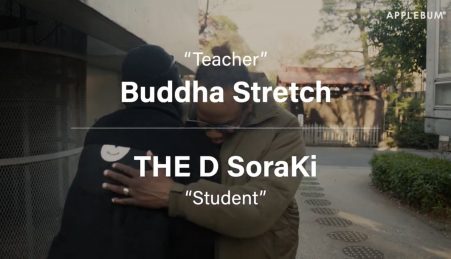
2024年6月28日 『Teacher & Student』対談 THE D SoraKi × Buddha Stretch
『Teacher & Student』対談 THE D SoraKi × Buddha Stretch アパレルブランド『APPLEBUM』がSTREET DANCERを招いて世に発信しているダンス動画『Unde…
-
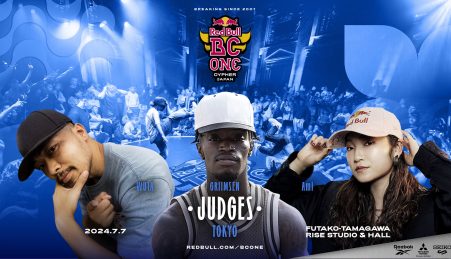
2024年6月21日 Red Bull BC One Japan Final 2024
20年以上の歴史を誇る、世界レベルの1on1ブレイキンバトルRed Bull BC One Cypher Japan 2024 7/7(土)開催! B-Girl Amiがジャッジで登場、ラッパー 鎮座DOPENESSがゲ…


